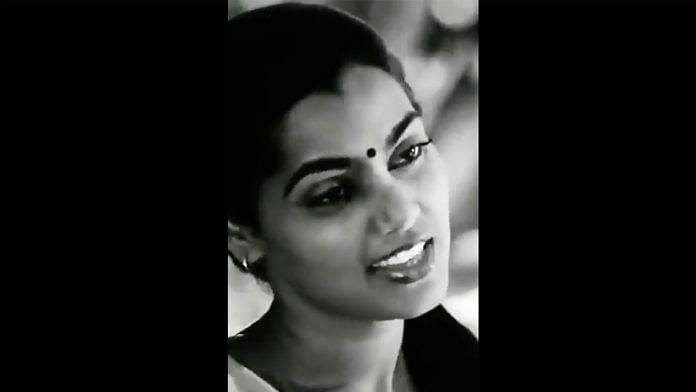New Delhi: In an era, when women shied away from expressing their sexuality, Silk Smitha was unapologetic about it.
Tamil screenwriter and author of A History of Tamil Cinema, Randor Guy recalls that “she was a voluptuous, extremely good-looking woman. This led to her being ‘exploited’ by men (for) most of her youth. To solve this, her family married her off at a very young age”. After being abused by her husband, she ran away and sought refuge in the film industry in Chennai.
In 1979, she finally got her chance to debut in a Malayalam film called Inaye Thedi. However, Tamil movie Vandichakkaram was the film that grabbed everyone’s eyeballs and libidos. She was cast as a bar dancer named Silk and was christened as Silk Smitha after this movie.
Seducing South India
Smitha is fondly remembered for her over-the-top, flashy, glamorous costumes and her electric screen presence, even today. Randor Guy, who shared a deep friendship with her said, “Films that had lain in cans for years were sold by the simple addition of a Silk Smitha song.”
It wasn’t just her dance moves or her sometimes gaudy, sometimes glamorous costumes that were appreciated by the audience, her complete sense of abandon added to her immense sex appeal and had people lining outside theatres.
Her ‘thunder thighs’, the chutzpah with which she looked right into the camera, curled her lips and indulged in those pelvic thrusts — challenged the conventional notions of female attractiveness and propriety.
Tamil film historian S. Theodore Baskaran, author of The Eye of the Serpent, said it best: “Silk Smitha says ‘let’s go to the temple’, and she manages to even make that sound sexy.”
The character actor
Silk Smitha was very different from the new age ‘item girl’ whose screen time is synonymous with the length of a song. She was a character in her films, one who displayed agency and would get what she wanted.
In an interview with Filmfare, she expressed her deep desire to be a character actress.
“I’d love to make a name for myself as a character actress. But I’ll never insist that I will only do serious roles. You see I depend on my producers and directors for my success. They have utilised my talents to sell their films, but in the process, they have also made me what I am,” she said.
A few roles were different from Silk Smitha’s conventional ones. In 1981, Bharathiraja directed Alaigal Oyvathillai (Ceaseless Waves), Smitha played the role of a Christian zamindar’s wife. In a particular scene, Smitha’s character ‘protects her husband’ as he rapes his servant’s wife and brings to screen a range of complex emotions.
A controversy-plagued life
In a short span of four years, Smitha was cast in over 200 Tamil, Malayalam, Kannada, Telugu and Hindi films and with such fame, also came controversies and mindless allegations.
During an interview conducted in December 1984, she claimed, that people “accused me of being disrespectful towards senior colleagues and artistes like Sivaji Ganesan, because I sit with my legs crossed in front of them. It is my habit to sit with my legs crossed when I am relaxing. I have been that way since childhood. Nobody had ever told me that was bad manners”.
Her sense of abandon, coupled with innocence, may have singled her out in the industry and Smitha was aware that she had attracted haters over the course of her career.
“Just about four years and in this time I have acted (in) over 200 films. Naturally, there must be several people who were jealous of my success,” she said.
The city that fulfilled all her dreams eventually also deprived her of them. She was found dead in her apartment in Chennai on 23 September 1996. She was just 36.
No one in the industry was able to explain her suicide. Some believed that “she was battling multiple problems, including a financial crunch, disillusionment in love and severe depression”.
Also read: Durga Khote, the ‘mother’ of Hindi & Marathi cinema who broke social taboos



